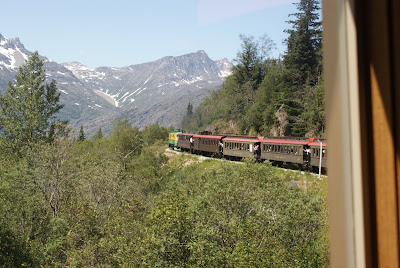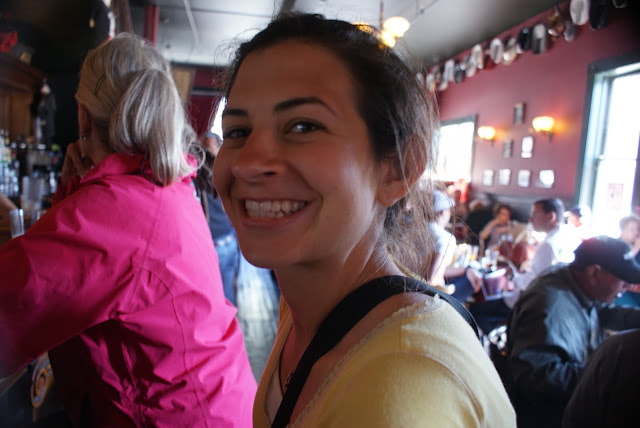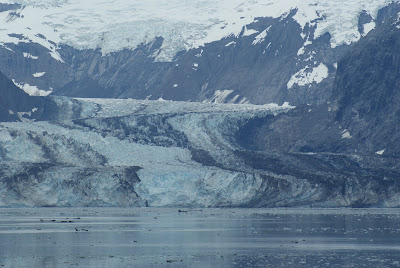Skagway is a fun little town, and by little we mean really small- as one of the locals told us, it has one grocery store, one hardware store, one bank, and 27 jewelry stores! It was blessed with a deep harbor, which explains it's genesis and why it is a typical stop for cruise ships (and by the way, almost all of those jewelry shops and the many, many souvenir shops in town, and in all ports in Alaska, close up after the "season" and the employees work the rest of the year in the Caribbean). The population of just over 800 doubles in the summer; part of Jack London's Call of the Wild was set there.
In 1896 gold was discovered in the Yukon, in British Columbia; Skagway was the closest place to bring in a boat ( a guy with incredible foresight built a dock in Skagway and make a claim for 160 acres a decade earlier). The gold rush that followed swelled the population of Skagway to as much as 30,000; prospectors would take a ship to Skagway and then climb the Chilkoot trail to the gold fields- some 500 miles away; by law the prospectors had to bring at least 1,000 pounds of supplies with them to survive the arduous climb. Many decided to pass on that adventure and settle in Skagway instead. Eventually an Englishman convinced investors to build a railway line to the Yukon, and the White Pass and Yukon Railroad line was created; by the time it was finished the gold rush was done (it lasted less than two years) and the population of Skagway had fallen dramatically. The railway line survived until the late 20th century carrying ore, and then closed. It was reopened recently to carry tourists and based on our experience, is doing very well since almost every seat was sold on the train. Leah and Alan took the train while Ruth and Danny stayed back and sunned (again the weather was incredible). Here's a few shots taken from the train:
 |
| It's a narrow gauge train and has to be to go around the cliffs like this! |
 |
| This was a bus driver; Leah and I liked his hat. |
 |
| Some of these buildings are original; the sidewalk is wooden planks. The power lines probably were not there in the 19th century but the mountains behind the town sure were! |
 |
| The Red Onion Saloon where you can get old fashioned food- we had a beer and a hummous appetizer Note the bedpans decorating the back wall. |
The other great thing about Glacier Bay was all of the wildlife we saw. We saw plenty of whales, but typically that simply means that we saw them spout, and sometimes see their tail flip:
On this cruise, however, we were lucky because several times the humpback whales breached (jumped out of the water) which the Ranger said was very unusual that close to a ship. We were lucky to get a couple of pictures.
There were also dozens of sea otters; many swam right next to the ship; this one practically swam onto our balcony!
 |
| Sea otters swim on their backs; note this one is carrying her pup on her stomach |
The next day we sailed to College Fjord, a group of several glaciers around a lake. Each of them is named after an Ivy League College (except Princeton). According to Wikipedia (forgive me for using Wiki for my reference):
The fjord contains five tidewater glaciers (glaciers that terminate in water), five large valley glaciers, and dozens of smaller glaciers, most named after renowned East Coast colleges (women's colleges for the NW side, and men's colleges for the SE side). College Fjord was discovered in 1899 during the Harriman Expedition, at which time the glaciers were named. The expedition included a Harvard and an Amherst professor, and they named many of the glaciers after elite colleges. According to Bruce Molina, author of Alaska's Glaciers, "They took great delight in ignoring Princeton."[
 |
| A bunch of Glaciers on the SouthEast Side |
 |
| One on the NorthWest Side |
 |
| Here's Harvard Glacier, for Steven |
 |
| Here's Yale Glacier, right next to Harvard Glacier |
After leaving College Fjord, the ship put it into high gear to get us to our final destination, Whittier. There isn't much to say about Whittier outside that Princess docks its ships there and it's about an hour from Anchorage depending on the tunnel (see our next post about the tunnel). Here is the Princess train taking many of our cruisemates to Denali National Park (they had to get off the ship before 6 in the morning- but not us!)
We got off at a civilized 8:45 and met Steven. Finally the five of us together again!
Next Post: Our Week with Steven and Tammy and Meet the Rams!!!


















For the record, history man, Whittier was a VERY important site for WWII. http://en.wikipedia.org/wiki/Whittier,_Alaska; http://www.dot.state.ak.us/creg/whittiertunnel/history.shtml (there are some who believe the town was used to hide something from the enemy . . . likely submarines given how deep it gets so quickly).
ReplyDelete